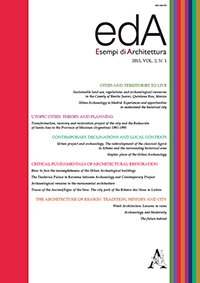Estratto da
ESEMPI DI ARCHITETTURA
International Journal of Architecture and Engineering
How to face the incompleteness of the Urban Archaeological Buildings
ESEMPI DI ARCHITETTURA
International Journal of Architecture and Engineering
How to face the incompleteness of the Urban Archaeological Buildings

The relationships between archaeological buildings and contemporary city can be observed through material and immaterial features (topographical, morphological, social, and cultural aspects) and can be considered a privileged point of view not only for the Past, but also for the Present and the Future of an urban settlement and its inhabitants. Several studies, carried out by researchers of different disciplines, have focused on this issue that is very relevant considering the permanence of archaeological vestiges as one of the distinctive identity-making factors of many European cities. Every archaeological building has a unique consistence. The relationships with the current surroundings are always complex and must be studied on a case-by-case basis. Nevertheless, a methodology could be applied to face the need of appropriate and reliable interventions on urban built archaeology. This is an essential aim, considering that the client is mostly public and the stakeholders are recognizable both in individual and in collective sphere, both in contemporary and in future generations. The urban archaeological buildings raise many well-known questions. This paper proposes the incompleteness as an original keyword to summarize most of them, also referring to the wider field of the Architectural Heritage. The idea of incompleteness will shortly explain some critical situations recurring in the activities on the Architectural Heritage (knowledge, conservation, and enhancement processes). Thereafter the incompleteness will be referred to the conditions of the Architectural Heritage (and in particular of the urban archaeological buildings), including both physical and immaterial dimensions. Considering the multifaceted incompleteness as a barrier that can limit the knowledge, the conservation and the enhancement, the final aim of every action on the urban archaeological buildings is an impermanent, notional, and emotional entirety (of knowledge, meanings, relative physical conditions, appropriate utilization, community participation) to be pursued by a proper methodology.
| pagine: | 71-82 |
| DOI: | 10.4399/97888548858687 |
| data pubblicazione: | Luglio 2015 |
| editore: | Aracne |








